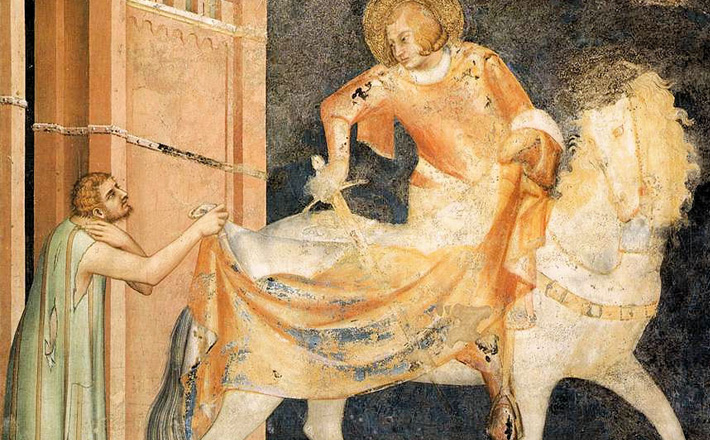Commentary on 1 Corinthians 3:10-11, 16-23
At the beginning of this text, Paul moves from the image of the church as a field (verses 6-9a) to explore more fully the image of the church as a building (verse 9b).
Paul says that in his apostolic mission at Corinth, he worked as a “wise” master builder. The NRSV rendering of this as “skilled” misses the important echo of Paul’s earlier discussion about wisdom and foolishness (1:18-2:16).
The point about Paul’s work is not just that he had skill in managerial tasks or that he was clever and effective in dealing with people. Rather, God’s wisdom is the cross of Christ, and Paul’s work was aligned with that foundational reality. True wisdom does not lie in the power, eloquence, social standing, or cultural competition that seemed to enthrall the Corinthian church (or any similar things that enthrall us). A building must fit its foundation, supported by it and shaped to match it, and Paul wisely built the Corinthian church on Christ crucified as the church’s one foundation (see 2:1-5).
Verses 16-17 continue to develop the metaphor of a building and make it more specific: the church is not just any building, but the temple of God, the place of God’s presence. In the context of a large Roman city with plenty of impressive marble temples, and when the Jewish temple was still standing and functioning in Jerusalem, Paul’s claim is bold and profound. It is not just that wherever God’s people live has become holy ground (though that too is true), but that the shared life of the community is indwelt by God.
Paul is not, at this point, discussing God’s presence with each individual believer. Rather, Paul’s focus is communal. It is the community of faith, “you together,” that is the holy place of God’s presence and glory. This is the third image that Paul has used in chapter 3 to describe the community of the church forming a single reality: field, building, and now temple. This is a reminder that authentically Christian spirituality is rooted in life together as the community of God’s people, and rooted in the working of God within those very real human relationships.
It is a surprise — and a gracious one — that Paul says such a thing to the Corinthian congregation. Even these messed-up Corinthians, these people of “flesh,” these babies in faith (3:1), are still the temple, the inner sanctuary. God dwells in their midst, in the fellowship and faith that they share. This promise provides hope in the face of the church’s very human faults and struggles.
We ought to notice that not only did Paul address them at the beginning of the letter as “holy ones” (1:2, NRSV “called to be saints”), but that more recently Paul reminded them that Jesus himself is the church’s holiness from God (1:30). There are times when we have painful disagreements about what holiness involves, what it means we ought to do and be, and what holiness looks like in human lives and communities. That work of discernment will continue to be part of the church’s life, but it must take place on the foundation of Christ crucified as the shape of God’s wisdom and holiness. Furthermore, such holy discernment will take place because the Holy Spirit is at work within the life of the church.
Verse 17 and its promise of retribution against any who would destroy the church could easily be misused in self-serving and vindictive ways, a weapon aimed at those who dare to disagree with whoever is wielding it. The church knows too well the pain and destruction that comes from that approach; we need a more helpful and faithful way to hear this warning.
While people may still experience some sense of holy awe about the spaces and material objects at the center of the church’s worship, we often treat the unity and peace of the church as something disposable and easily sacrificed. It would not be difficult for most pastors to think of a long list of ways in which that web of love and unity can be frayed and broken. Verse 17 may be difficult for us to hear not only because we have a difficult time finding a place for God’s judgment within a healthy spirituality, but also because we don’t think God cares that much about the unity of the church and how we relate to one another. Paul disagrees.
Being God’s holy people will mean not living by the world’s criteria for wisdom, piety, or power. Verses 18-20 return to Paul’s contrast between God’s wisdom and the ways of the world’s “wise ones.” That distinction should put a halt to the kind of boasting that Paul had addressed in chapter 1.
There, we learned that the Corinthians were claiming that they “belonged” to particular leaders (perhaps denominationalism is the parallel problem for us). But Paul now argues that a proper perspective about God’s wisdom in Christ should completely reorient the conversations in Corinth. The church does not belong to itself, and it certainly does not belong to any other human, but to Christ alone.
Paul’s declaration in verse 21-22 that all things belong to the church does not mean that the church ought to expect (or seek) riches and property. Rather, the church needs to see all things and all people through the lens of who we are — God’ people in Christ who have been called, fed, and sent for the sake of the world (see 2 Corinthians 5:16-21).
The people and things of the world (including the leaders the Corinthians are fighting over, and the brothers and sisters they are fighting with) are not there to advance our individual agendas, and they are not there to be exploited and used. They are there as recipients of God’s redeeming love. That love is the shape of the temple we are called to be, fitted to the foundation of Jesus himself.


February 23, 2014